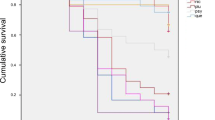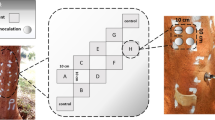Abstract
The severity of natural infections induced by the root rot fungus Collybia fusipes depends on soil factors. Severely infected trees usually show reduced vigour, as evidenced by poor growth. However, it is not known whether reduced vigour could be a cause of the severe infection. The objective was to clarify the relationships between soil factors, tree vigour and susceptibility of Quercus robur to C. fusipes by artificially inoculating mature trees. Two experiments compared oak trees of different ages and dominance class and oak trees growing on different type of soils. The inoculum survival and the infection success were poor in both experiments when waterlogging was severe. Inoculum survival was better in soil with increasing sand/clay ratio, carbon/nitrogen ratio and decreasing pH and calcium, magnesium and phosphorus availability. The relationships between oak vigour and success of infection or surface area of lesions were inconsistent, with a slightly higher infection success on co-dominant/suppressed oaks in one experiment and a higher surface area of successful infection on dominant oaks in the second.
Similar content being viewed by others
References
AFNOR (1999) Qualité des sols. Recueil des normes françaises. 4eédition, Paris-La Défense
Becker M and Lévy G (1990) Le point sur l'écologie comparée du chêne sessile et du chêne pédonculé. Revue Forestière Française 42: 148-154
Becker M, Nieminen TM and Geremia F (1994) Short-term variations and long-term changes in oak productivity in northeastern France. The role of climate and atmospheric CO2. Annales des Sciences Forestières 51: 477-492
Blenis PV, Mulaga MS and Hiratsuka Y (1989) Soil affects Armillaria root rot of lodgepole pine. Canadian Journal of Forest Research 19: 1638-1641
Buller HAR (1958) The perennial pseudorhiza of Collybia fusipes. In: Researches on Fungi, Vol 6 (pp 374-396) N.Y. Hafner Publishing CO, USA
Camy C and Marçais B (2002) Relation between soil factors, root infection by Collybia fusipes, and tree health, in Quercus robur and Q. rubra. In: 10th International Conference on Root and Butt rots (pp 71-77), Québec, Canada
Camy C, Delatour C and Marçais B (2003a) Relationships between soil factors, Quercus robur health, Collybia fusipes root infection and Phytophthora presence. Annals of Forest Science (in press)
Camy C, Dreyer E, Delatour C and Marçais B (2003b) Collybia fusipes, soilwaterlogging and oxygen availability. Mycological Research (in press)
Camy C, de Villebonne D and Marçais B (2003c) Soil factors associated with decline of oaks and infection by Collybia fusipes. Forest Pathology (in press)
Collet D (1991) Modeling Binary Data, Chapman and Hall, London, UK
Davidson AJ and Rishbeth J (1988) Effect of suppression and felling on infection of oak and Scots pine by Armillaria. European Journal of Forest Pathology 18: 161-168
Delatour C and Guillaumin JJ (1984) Un pourridié méconnu: Collybia fusipes (Bull. ex Fr.) Quel. Comptes Rendus de l'Académie d'Agriculture de France 70: 123-126
Goheen E and Hansen E (1994) Tree vigor and susceptibility to infection by Phellinus werii: Results of field inoculations. In: Johansson M and Stenlid J (eds) 8th International Conference on Root and Butt Rots. Wik, Sweden and Haiko, Finland (pp 45-51) Swedish University of Agricultural Sciences, Uppsala, Sweden
Guillaumin JJ, Bernard C, Delatour C and Belgrand M (1985) Contribution à l'étude du dépérissement du chêne: pathologie racinaire en forêt de Tronçais. Annales des Sciences Forestières 42: 1-22
Kreisel H (1961) Die phytopathogenen Grosspilze Deutschlands. VEB Gustav Fischer-Verlag, Jena
Lévy G and Lefèvre Y (2001) Les contraintes subies par les arbres sur sol à nappe temporaire. La forêt et sa culture sur sol à nappe temporaire, Engref, Nancy, France
Marçais B and Caël O (2000) Comparison of the susceptibility of Quercus petraea, Q. robur and Q. rubra to Collybia fusipes. European Journal of Plant Pathology 106: 227-232
Marçis B and Caël O (2001) Relation between Collybia fusipes root rot and growth of pedunculate oak. Canadian Journal of Forest Research 31: 757-764
Marçais B and Delatour C (1996) Inoculation of oak (Quercus robur and Q. rubra) with Collybia fusipes. Plant Disease 80: 1391-1394
Marçais B, Caël O and Delatour C (1998a) Investigations on the distribution and impact of Collybia fusipes in Oak forest, In: Delatour C, Guillaumin JJ, Lung-Escarmant B and Marçais (eds) 9th International Conference on Root and Butt Rots of Forest Trees, Carcans-Maubuisson, France (pp 215-222) INRA, Colloques de l'INRA no. 89, Paris, France
Marçais B, Martin F and Delatour C (1998b) Structure of Collybia fusipes populations in two infected oak stands. Mycological Research 102: 361-367
Nisbet TR, Mullins CE and Macleod, DA (1989) The variation of soil water regime, oxygen status and rooting pattern with soil type under Sitka spruce. Journal of Soil Science 40: 183-197
Piou D, Delatour C and Marçais B (2002) Hosts and distribution of Collybia fusipes in France. Forest Pathology 32: 29-41
Piri T (2000) Response of compensatory-fertilized Pinus sylvestris to infection by Heterobasidion annosum. Scandinavian Journal of Forest Research 15: 218-224
Redfern DB (1978) Infection by Armillaria mellea and some factors affecting host resistance and the severity of the disease. Forestry 51: 121-135
Redfern DB (1983) Factors affecting spread of Heterobasidion annosum in plantations, In: Kile GA (ed) 6th International Conference on Root and Butt Rots of Forest Trees. Melbourne, Victoria and Gympie, Queensland, Australia (pp 104-109) CSIRO, Melbourne, Australia
Redfern DB (1998) The effect of soil on root infection spread by Heterobasidion annosum, In: Delatour C, Guillaumin JJ, Lung-Escarmant B and Marçais B (eds) 9th International Conference on Root and Butt Rots of Forest Trees, Carcans-Maubuisson, France (pp 267-273) INRA, Colloques de l'INRA no. 89, Paris, France
SAS Institute Inc. (1989) SAS/STAT User's Guide, Version 6, 4th edn, Vol I Cary
Singh P (1983) Armillaria root rot: Influence of soil nutrients and pH on the susceptibility of conifer species to the disease. European Journal of Forest Pathology 13: 92-101
Wargo PM and Houston DR (1974) Infection of defoliated sugar maple trees by Armillaria mellea. Phytopathology 64: 817-822
Author information
Authors and Affiliations
Corresponding author
Rights and permissions
About this article
Cite this article
Camy, C., Delatour, C., Caël, O. et al. Inoculation of Mature Pedunculate Oaks (Quercus robur) with the Root Rot Fungus Collybia fusipes: Relationships with Tree Vigour and Soil Factors. European Journal of Plant Pathology 109, 545–553 (2003). https://doi.org/10.1023/A:1024742419540
Issue Date:
DOI: https://doi.org/10.1023/A:1024742419540




